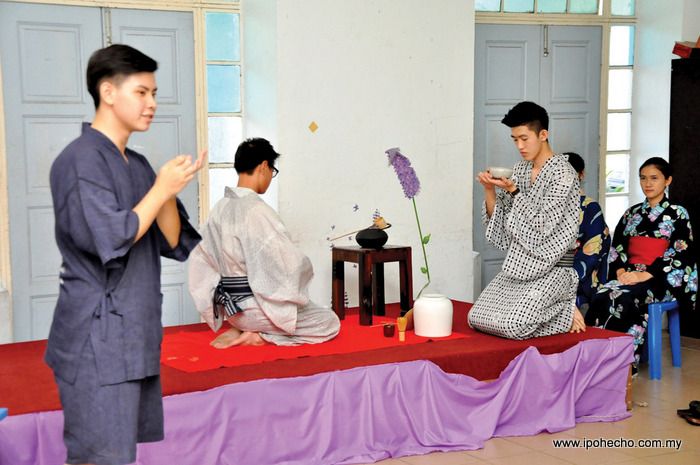

A Japanese legend says that if you fold one thousand paper cranes, you would be granted a wish. Against a hanging backdrop of the iconic Mount Fuji, pieced together using over a thousand paper cranes, SMK Anderson’s first-ever Japanese Cultural Day was held on Saturday, August 22 at the school hall. It was a lively affair.
The teaching of Japanese as a foreign language in the school began in 2013. “This year, the Ministry of Education and The Japan Foundation Kuala Lumpur sent a Japanese native, Madam Okubo Sachiko to teach Japanese language in this school together alongside me for a year. Together, we came up with this idea,” Loh Kok Hoong, the teacher-in-charge explained told Ipoh Echo.
After the opening ceremony, the principal, Zahidi Abd Ghani accompanied the guests-of-honour, Shoichi Toyoda, Director of The Japan Foundation Kuala Lumpur and North Kinta District Education Officer Hj Hasni Hashim to the exhibition cum workshop site which displayed ikebana (Japanese art of flower arrangement), chakai (Japanese tea ceremony), origami (Japanese art of folding paper into decorative shapes) and pottery. Plus, there were competitions for calligraphy and story reading for Andersonians and the more than 100 invited students from as far as Penang.
“Origami doesn’t involve use of scissors and glue, we just need to fold and assemble. Today we’re teaching the kids to fold a top,” said Goh from the Perak Malaysian-Japanese Friendship Society to Ipoh Echo. Goh has been dabbling in the craft for the past three decades for the purpose of display and charity besides being her hobby.


On the pottery front, Sook Peng from The Living Art Ceramics when asked the reason behind her passion said, “From a piece of clay, I build the shape, add colours and fire it in the kiln. When the completed work emerges, the joy it brings is immeasurable.” She has been involved in the art since 2000 and was teaching the eager students the basic technique of making a cylinder vase with natural clay for that day.
The ikebana display brought this comment from Fatin, a Form 2 student from Sekolah Menengah Sains Kepala Batas, Penang, “The best part is we could bring back the flower arrangement and pottery that we created.”
The memorable day also saw Imai Thubasa playing the sanshin (an Okinawan musical instrument) and then the guitar accompanying the audience in a singalong Japanese song entitled, ‘Tomorrow will Come’.
As the half-day event drew to a close, I caught sight of the tanabata decoration of coloured papers in rectangular strips fluttering from bamboo branches. On each was printed the students’ wishes. One said, “I wish I can go to Japan one day”. I too hope for the same.
Mei Kuan


